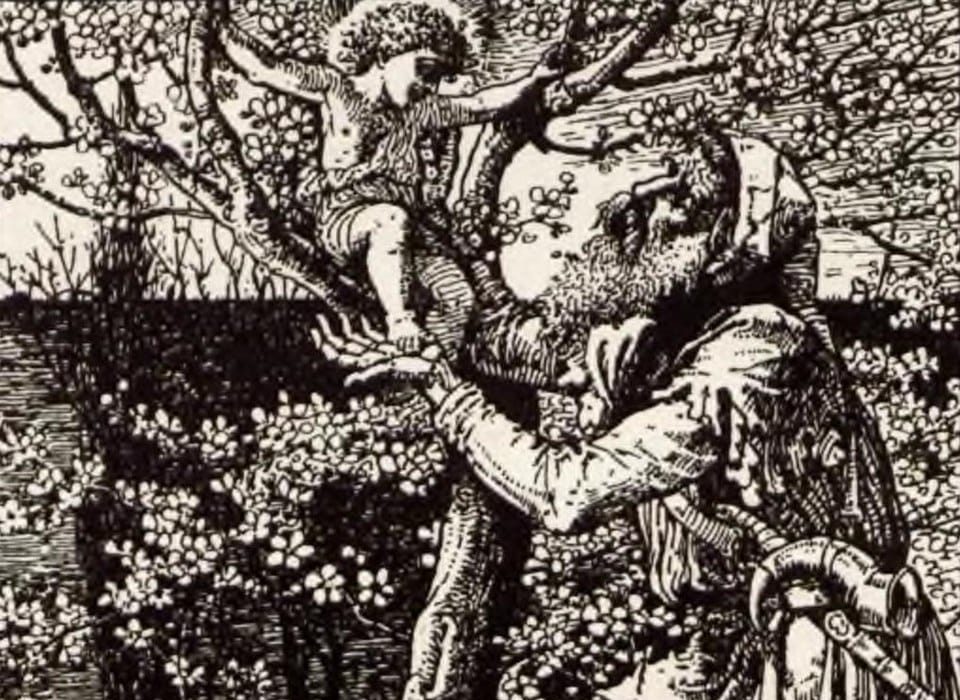Heavy spoilers for Stephen King’s Fairy Tale
It’s difficult growing up. It’s even more difficult when you have man-eating giants and skeletal wizards to contend with. In Stephen King’s Fairy Tale, a young boy named Charlie Reade ventures into a land of make-believe. There, he learns about loss and hardship, ultimately transforming from a young boy into a full-grown adult.
Previously, we discussed the concept of bildungsroman. This is a fancy way of saying “coming of age” when we are discussing a story. In this post, we will examine the conventions of a bildungsroman. Then, we will see how it compares to Stephen King’s novel about shoes on a line, reverse-aging dogs, and rather large crickets.
Plot Summary
Before the Fantasy
The novel begins with Charlie Reade reeling from the death of his mother and his father’s (George) fall into alcoholism. The first section of the novel establishes Charlie as a caring yet frustrated child. His father is absent from a crucial moment of trauma mending. Eventually, Charlie’s father gets the help he needs, and they move on with their lives successfully.
One day, Charlie meets old man Bowditch, who is a cantankerous misanthrope that lives by himself in his old house in town. After helping the man after a bad accident, Charlie tends to Bowditch’s dog, Radar. The dog is a large, albeit aging, German Shepherd. Charlie begins to love Radar and insists on caring for him, and he also discovers that Mr. Bowditch has access to a great deal of golden pellets, which have set the old, cranky man for life.
After Mr. Bowditch dies of a heart attack, it is revealed through a recording to Charlie that Mr. Bowditch has been able to go through a portal of sorts in his backyard. Here, he can voyage to another world called Empis—one of fantasy and horror.
During the Fantasy
Charlie, fearing for Radar’s age and health, decides to take the dog to this land for healing. Similarly, Bowditch was able to use a huge, magical sundial to reverse years of his own life (living until he was 120 years old). In this new land, Charlie saves Radar but is captured by an army of undead monsters, known as “night soldiers.” He is taken to Deep Maleen where he is subjected to torture. Afterward, he is forced to fight his fellow captives in gladiatorial combat. Charlie is able to escape during a pivotal tournament after discovering his lineage as one of the princes and heroes of Empis.
After reconvening, Charlie and his new group of friends venture back into the city to destroy a source of evil so powerful that it could consume all of Empis and possibly the real world.
The Conventions of Bildungsroman
A bildungsroman has a straightforward component: the story must feature a person who travels from inexperience to experience. As such, the main characters do not need to be a child, but that is often the easiest way to change from youth to adulthood. For example, think about King Arthur as a boy transformed into King Arthur the man.
As the School of Writing, Literature, and Film for Oregon State University writes, “While the Bildungsroman is also often labeled using slightly different terminology—like ‘the novel of education’ or the ‘coming-of-age novel,’ the essence of the Bildungsroman is the process of the main character forming his or her own self through whatever degree of freedom and individuality they can wrest from forces that are larger than them” (Schwartz).
What this means is that some learning has to happen in order for the protagonist to change into their older, wiser self.
“Fairy Tale” as bildungsroman
Keeping it simple, the story of Charlie Reade is one of growth and exploration… and exploration in a literal sense. In the beginning, Charlie is lost and confused, as his mother was tossed away by fate (having been hit by a truck while on a walk to get dinner for her family), and his father is a hopeless alcoholic. Here, Charlie is in his infantile state of seeing the world. He can’t comprehend his mother’s death, and he struggles with anger toward his father even though he loves him.
Strangely, the story works as a double-bildungsroman (if that’s a thing), as the narrative arc of Charlie grappling with his father’s alcoholism shows a great change between both of the characters; in fact, I almost thought it would make a fantastic book by itself if it was just this section of the novel up until the death of Mr. Bowditch.
Regardless, even as Charlie travels to this new world through a tunnel, the reader sees a change in the landscape—and Charlie’s perception of the world.
Excerpt
From the novel:
I reached the opening and saw the ceiling overhead was now earth, with fine tendrils of root dangling down. I ducked under some overhanging vines and stepped out onto a sloping hillside. The sky was gray, but the field was bright red. Poppies spread in a gorgeous blanket stretching left and right as far as I could see. A path led through the flowers toward a road. On the far side of the road more poppies ran maybe a mile to thick woods, making me think of the forests that had once grown in my suburban town. The path was faint, but the road wasn’t. It was dirt but wide, not a track but a thoroughfare. Where the path joined the road, there was a tidy little cottage with smoke rising from the stone chimney. There were clotheslines with things strung on them that weren’t clothes. I couldn’t make out what they were.
I looked to the far horizon and saw the skyline of a great city. Daylight reflected hazily from its highest towers, as if they were made of glass. Green glass. I had read “The Wizard of Oz” and seen the movie, and I knew an Emerald City when I saw one.
Charlie has already changed from a naive boy who couldn’t believe in fantasy and magic, and now a revelation has given him new insight into himself and the world around him. If it was possible to see the Emerald City, it was certainly possible to see other outlandish things in the land of Empis. That shows a change in character. Thus, when Charlie faces down an angry man-eating giant, we can believe his fear, and we can also believe his resolve.
Later in the novel, Charlie leads his friends to safety and back into the jaws of chaos with his newfound heroism and desire to fix a broken land that was once beautiful and serene.
Conclusion
The big takeaway here is that a bildungsroman causes change in a character. The character is typically youthful, though this can be contested, and they eventually grow into their mature self through trials and tribulations. Charlie starts as a child of 17 and eventually becomes a man and hero of a magical world. Stephen King’s Fairy Tale naturally fills the void of expectation between childhood and manhood. Bildungsroman fulfilled.
Works Cited
Collis, Clark. “Read an Exclusive Excerpt from Stephen King’s Forthcoming Novel Fairy Tale.” Entertainment. Jan. 24, 2022. Web.
King, S. (2022). Fairy Tale. Scribner.
Schwartz, Sam. “What is a Bildungsroman? | Definition and Examples.” Oregon State University. March 4, 2024. Web. https://liberalarts.oregonstate.edu/wlf/what-bildungsroman-definition-examples





Leave a comment